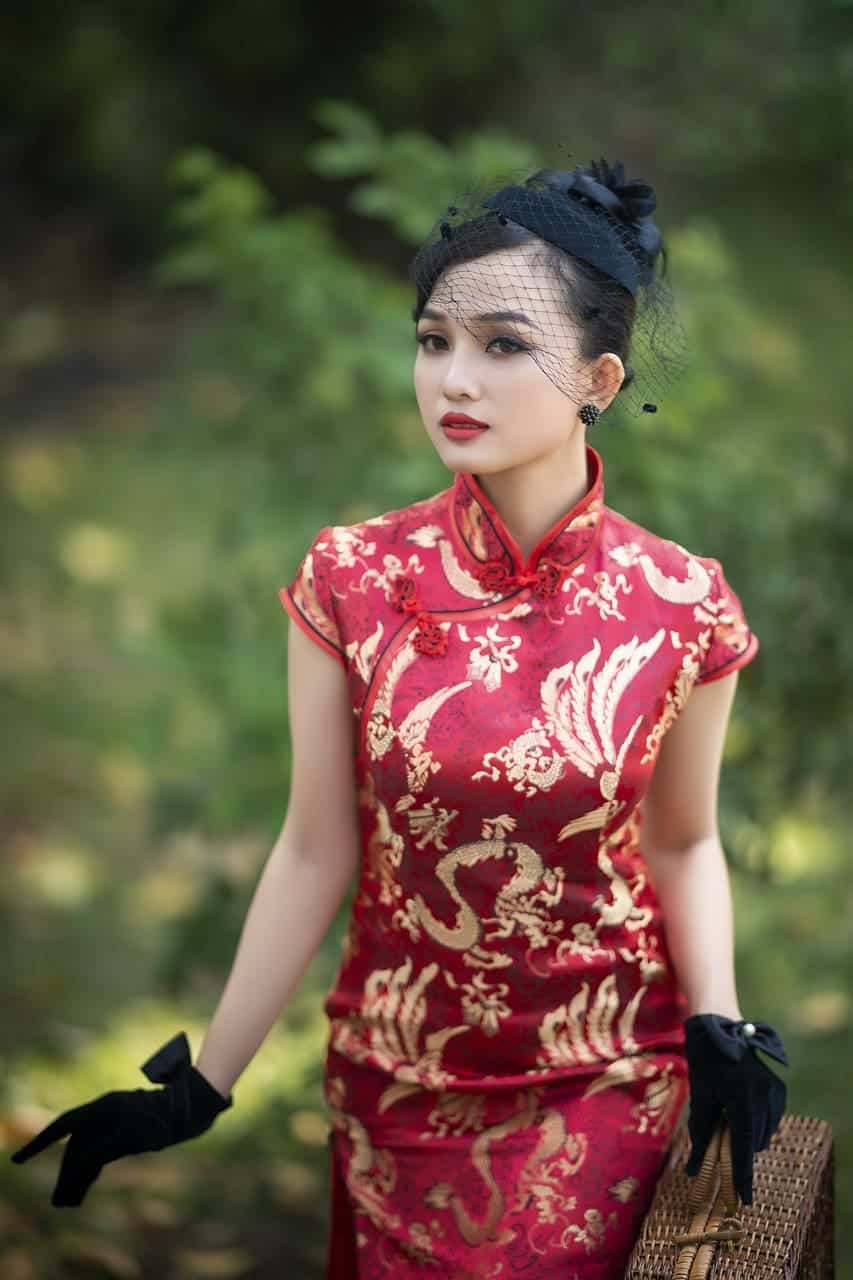Today, in China, Qipao and Cheongsam are two names of the same dress. The dress is considered the epitome of Chinese fashion.
However, they are originally two different dresses and due to various historical incidences, the names overlapped, and with time, they became the same dress. Nevertheless, the original dresses carried significant differences.
Key Takeaways
- Qipao is a traditional Chinese dress with a high collar, short sleeves, and side slits, while cheongsam is a modern adaptation with a form-fitting silhouette.
- Both Qipao and Cheongsam originated in China, but cheongsam gained popularity in the Western world.
- Qipao is more conservative in design, whereas cheongsam is more fashionable and versatile.
Qipao vs Cheongsam
Qipao, known as Cheongsam in Cantonese, is a traditional Chinese dress that originated in the Qing Dynasty (1644-1911) but gained popularity in the 1920s-1930s, used in Mandarin-speaking areas. Cheongsam is a term to a Chinese dress that is used in Hong Kong and other Cantonese-speaking regions.

Qipao means ‘banner robe’. It is a Chinese dress that originated in the 16th Century during the Qing Dynasty. Linguistically, Qipao is a Mandarin dress worn by women of the Manchus, an ethical minority in China during that period.
The dress had designs of the minority’s banner, and the people of this movement were known as ‘banner people’.
Cheongsam means ‘long gown’. It is a Chinese dress that originated in the 20th Century, years after the decline of Qipao.
Linguistically, Cheongsam is a Cantonese dress that is largely worn by women of China and is considered the epitome of Chinese fashion. China is renowned for Cheongsam.
Comparison Table
| Parameters of Comparison | Qipao | Cheongsam |
|---|---|---|
| Meaning | It means ‘banner robe’. | It means ‘long gown’. |
| Year of Origin | It originated in the 16th Century. | It originated in the 20th Century. |
| Linguistic Origin | It is a Mandarin dress. | It is a Cantonese dress. |
| Weight | Qipao dresses were heavy. | Cheongsam dresses are lighter. |
| Significance | It is ethically significant. | It is the epitome of fashion. |
What is Qipao?
Qipao means ‘banner robe’. It is a Chinese dress that originated in the 16th Century during the Qing Dynasty. Linguistically, Qipao is a Mandarin dress worn by women of the Manchus, an ethical minority in China during that period.
The dress had designs of the minority’s banner, and the people of this movement were known as ‘banner people’.
During the Qing Dynasty in the 16th century, Nurhaci, a chieftain, created the Eight Banner System for Minorities.
The people of the movement were organized into eight different minorities, each with a representing banner or flag. These people were called the Manchus, who ruled China for over 2 centuries.
These people distinguished themselves from the country’s ordinary citizens by wearing clothes specific to their movement. Women wore banner robes, which were then known as Qipao.
The dress was loose, spread, and covered the whole body. All the women of the eight minorities wore Qipaos, with their specific banner imprinted on it.
When the Qing Dynasty ended in the early 20th Century, the Republic of China took over. As a consequence, various reforms promoted increased education for women.
In a very short time, younger women and students neglected Qipao, which led to its decline.

What is Cheongsam?
Cheongsam means ‘long gown’. It is a Chinese dress that originated in the 20th Century, years after the decline of Qipao.
Linguistically, Cheongsam is a Cantonese dress that is largely worn by women of China and is considered the epitome of Chinese fashion. China is renowned for Cheongsam.
Shortly after the rise of the Republic of China, Qipao-like long gowns were back in style, influenced by Western culture. The dress was revived with a few modifications, including a slimmer structure, better fitting, and various forms of sizes.
Over the years, the dress kept modifying concerning the modernization of fashion sense. Soon after, the dress was worn by celebrities and famous first ladies, further increasing its popularity.
By the 1930s, Cheongsam became the epitome of fashion in China and is still largely called so.
However, the dress again fell out of favour in the 1950s with the Communist Revolution. There has been no satisfactory explanation for it. The dress was seen as a symbol of feudal times in China and a bad influence by Western culture.
As all of this happened over a long period, the dress was now already largely popular. With the relocation of tailors over time, the concept of Cheongsam was known everywhere. It became practically impossible to eliminate its existence.

Main Differences Between Qipao and Cheongsam
- Qipao is a Mandarin dress, whereas Cheongsam is a Cantonese dress.
- Qipao carried historical significance to it as the Manchus wore it. On the other hand, Cheongsam doesn’t carry any such significance.
- Qipao dresses are ethical, whereas Cheongsam dresses are inclined towards fashion.
- Qipao dresses are heavy with many layers, whereas Cheongsam dresses are lighter with lesser or no layers.
- Qipao was loose and covered the whole body. On the other hand, Cheongsam is well fitted and not all of them cover the whole body.

- https://link.springer.com/chapter/10.1007/978-3-319-97199-5_15
- https://books.google.com/books?hl=en&lr=&id=OPuiDwAAQBAJ&oi=fnd&pg=PP1&dq=cheongsam&ots=zXZjVITUjk&sig=nwYjMDGtwdFwLxPjc5d9FUkz3f8

I knew the basics but I learned a lot from the comparison table. Great read!
Yes, It’s surprising to see such a vast difference in the meaning and origin of these two dresses.
Interesting how the popularity of the dresses changed over time.
I’m really surprised by this article, I’ve been using these terms as synonyms for years
I love the emphasis on the linguistic differences between the dresses.
This is a great article explaining the differences between these two cultural dresses. Very eye-opening!
This was a great informative article, I love reading about fashion and history. Thank you!
Yes, very educational indeed!
I didn’t expect to find this much information on the topic. Really well-researched. Thanks!